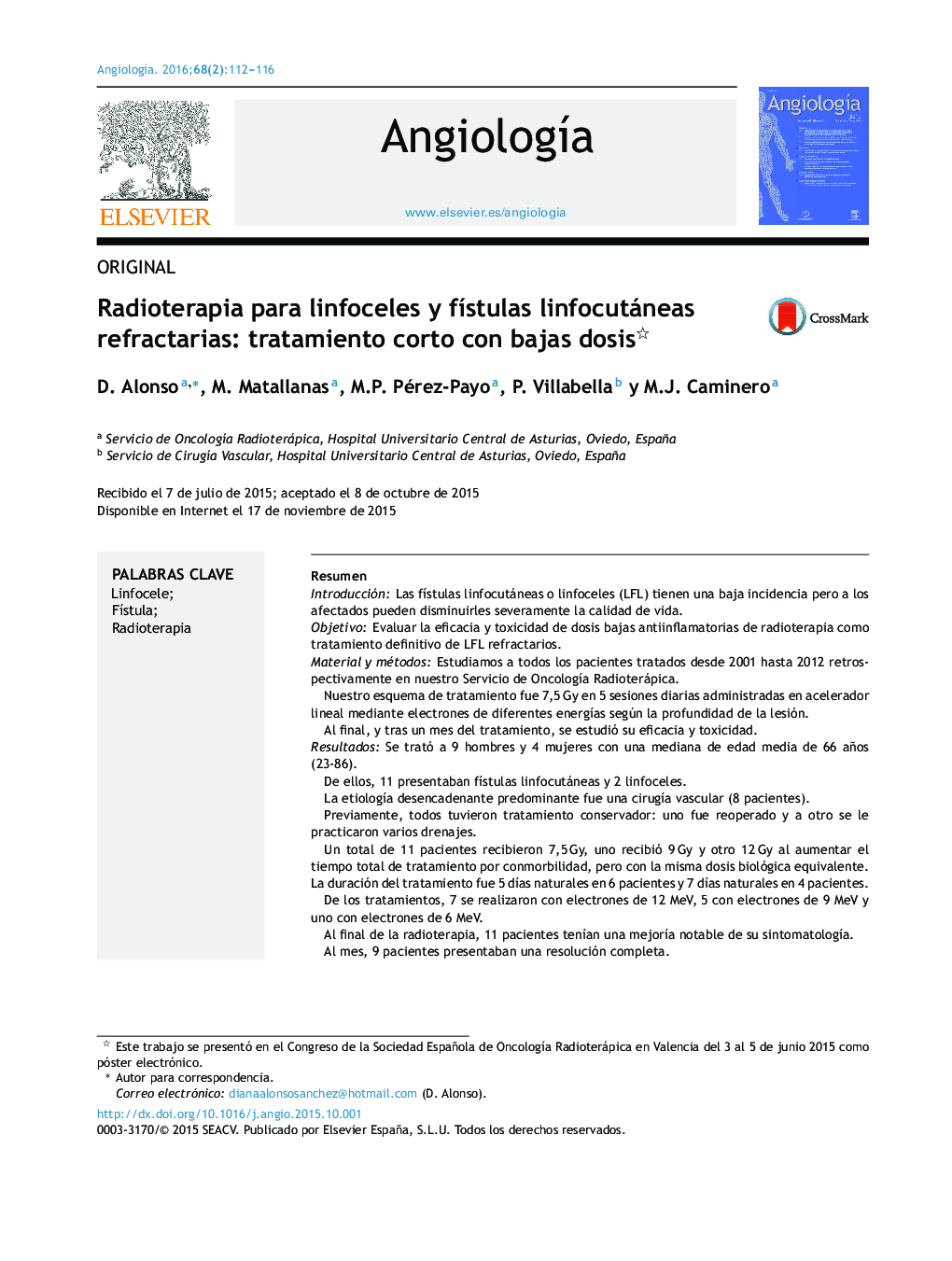| Article ID | Journal | Published Year | Pages | File Type |
|---|---|---|---|---|
| 2867333 | Angiología | 2016 | 5 Pages |
ResumenIntroducciónLas fístulas linfocutáneas o linfoceles (LFL) tienen una baja incidencia pero a los afectados pueden disminuirles severamente la calidad de vida.ObjetivoEvaluar la eficacia y toxicidad de dosis bajas antiinflamatorias de radioterapia como tratamiento definitivo de LFL refractarios.Material y métodosEstudiamos a todos los pacientes tratados desde 2001 hasta 2012 retrospectivamente en nuestro Servicio de Oncología Radioterápica.Nuestro esquema de tratamiento fue 7,5 Gy en 5 sesiones diarias administradas en acelerador lineal mediante electrones de diferentes energías según la profundidad de la lesión.Al final, y tras un mes del tratamiento, se estudió su eficacia y toxicidad.ResultadosSe trató a 9 hombres y 4 mujeres con una mediana de edad media de 66 años (23-86).De ellos, 11 presentaban fístulas linfocutáneas y 2 linfoceles.La etiología desencadenante predominante fue una cirugía vascular (8 pacientes).Previamente, todos tuvieron tratamiento conservador: uno fue reoperado y a otro se le practicaron varios drenajes.Un total de 11 pacientes recibieron 7,5 Gy, uno recibió 9 Gy y otro 12 Gy al aumentar el tiempo total de tratamiento por conmorbilidad, pero con la misma dosis biológica equivalente. La duración del tratamiento fue 5 días naturales en 6 pacientes y 7 días naturales en 4 pacientes.De los tratamientos, 7 se realizaron con electrones de 12 MeV, 5 con electrones de 9 MeV y uno con electrones de 6 MeV.Al final de la radioterapia, 11 pacientes tenían una mejoría notable de su sintomatología.Al mes, 9 pacientes presentaban una resolución completa.No se observó en ninguno de los casos toxicidad rádica aguda.ConclusionesEste tratamiento es eficaz, seguro y rápido para esta enfermedad, aun cuando otros tratamientos fracasaron.
IntroductionLymphocutaneous fístulas and/or lymphoceles (LFL) have a low incidence, but they can affect the quality of life of the patient.AimTo value effectiveness and toxicity of low dose radiotherapy as an anti-inflammatory curative treatment of LFL when other treatments are ineffective.Materials and methodsConsecutive patients treated in our department from 2001 to 2012 were retrospectively studied. Treatment schedule was 7.5 Gy in 5 daily sessions with linear acceleration electrons. Patients were reviewed at the end of treatment and one month after this.ResultsThe study included 9 men and 4 women, with a mean age of 66 (23-86) years old. There were 11 lymphocutaneous fístulas and 2 lymphoceles. Predominant aetiology: vascular surgery (8 patients). All had conservative treatment, one was also re-operated, and another was drained before radiotherapy.The total dose received by 11 patients was 7.5 Gy, in one it was 9 Gy and in another, 12 Gy. The total treatment time extension was 5 natural days in 6 patients, and 7 days in 4. Seven patients were treated with 12MeV, 5 with 9 MeV, and 1 with 6 MeV electrons.On the day of last treatment session, LFL had decreased in 11 patients, and in 9 of them it was completely resolved at one month.No radiation toxicity was observed.ConclusionsThis treatment is safe, effective and fast for this condition.
